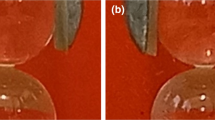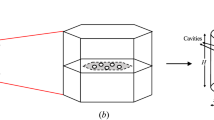Abstract
Effects of porosity play a key role in ductile fracture and many modern metals are less than fully dense with a finite porosity created either unintentionally (as in additively manufactured or powder processed materials) or intentionally (as in metallic meta-materials and foams). This study compares the Gurson and Cocks–Ashby models’ predictions of porosity evolution (kinetics) and material degradation against unit cell simulations of a strain-rate dependent material under varying triaxiality. Previous comparisons do not address varying triaxiality and direct comparisons between the Gurson and Cocks–Ashby models are limited. This study also uses triaxiality, flow stress, strain rate, and strain-rate sensitivity from unit cell simulations as inputs to each model to give an accurate depiction of the models’ performance under complex evolving loading and material states. A fitting procedure for porosity evolution is also shown. This study shows the overall predictive power of the Gurson model over the Cocks–Ashby model. It also highlights the accuracy of the Cocks–Ashby porosity evolution model and Cocks–Ashby degradation function when each model is calibrated independently.






















Similar content being viewed by others
References
Barton N (2017) Results from a new cocks-ashby style porosity model. In: AIP conference proceedings, AIP Publishing LLC, vol 1793, p 100029
Barton N, Rhee M, Li S, Bernier J, Kumar M, Lind J, Bingert J (2014) Using high energy diffraction microscopy to assess a model for microstructural sensitivity in spall response. In: Journal of Physics: Conference Series, IOP Publishing, vol 500, p 112007
Becker R, Callaghan K (2018) Evaluation of gurson yield function dependencies through large-scale void growth simulations. Int J Fract 209(1–2):235–240
Benzerga AA (2002) Micromechanics of coalescence in ductile fracture. J Mech Phys Solids 50(6):1331–1362
Benzerga AA, Leblond JB (2010) Ductile fracture by void growth to coalescence. In: Advances in applied mechanics, vol. 44, Elsevier, pp 169–305
Benzerga AA, Leblond JB, Needleman A, Tvergaard V (2016) Ductile failure modeling. Int J Fract 201(1):29–80
Cocks A (1989) Inelastic deformation of porous materials. J Mech Phys Solids 37(6):693–715
Cocks A, Ashby M (1980) Intergranular fracture during power-law creep under multiaxial stresses. Met Sci 14(8–9):395–402
Dassault-Systèmes, (2018) ABAQUS tanual: porous metal plasticity. Dassault Systèmes Simulia Corp, United States
Doraivelu S, Gegel H, Gunasekera J, Malas J, Morgan J, Thomas J Jr (1984) A new yield function for compressible pm materials. Int J Mech Sci 26(9–10):527–535
Duva J, Crow P (1992) The densification of powders by power-law creep during hot isostatic pressing. Acta Metall Mater 40(1):31–35
Duva J, Hutchinson J (1984) Constitutive potentials for dilutely voided nonlinear materials. Mech Mater 3(1):41–54
Gurson AL (1977) Continuum theory of ductile rupture by void nucleation and growth: Part I: yield criteria and flow rules for porous ductile media. J Eng Mater Technol 99(1):2–15
Johnson GR, Cook WH (1983) A constitutive model and data for metals subjected to large strains, high strain rates and high temperatures. In: Proceedings of the 7th international symposium on ballistics, The Netherlands, vol 21, pp 541–547
Koplik J, Needleman A (1988) Void growth and coalescence in porous plastic solids. Int J Solids Struct 24(8):835–853
Kweon S (2012) Damage at negative triaxiality. Eur J Mech A 31(1):203–212
Marin E, McDowell D (1998) Models for compressible elasto-plasticity based on internal state variables. Int J Damage Mech 7(1):47–83
McDowell D, Marin E, Bertoncelli C (1993) A combined kinematic-isotropic hardening theory for porous inelasticity of ductile metals. Int J Damage Mech 2(2):137–161
Michel J, Suquet P (1992) The constitutive law of nonlinear viscous and porous materials. J Mech Phys Solids 40(4):783–812
Moore JA (2018) A degradation function consistent with cocks-ashby porosity kinetics. Int J Fract 209(1–2):231–234
Moore JA, Li SF, Rhee M, Barton NR (2018) Modeling the effects of grain and porosity structure on copper spall response. J Dyn Behav Mater 4(4):464–480
Noble CR, Anderson AT, Barton NR, Bramwell JA, Capps A, Chang MH, Chou JJ, Dawson DM, Diana ER, Dunn TA, Faux DR, Fisher AC, Greene PT, Heinz I, Kanarska Y, Khairallah SA, Liu BT, Margraf JD, Nichols AL, Nourgaliev RN, Puso MA, Reus JF, Robinson PB, Shestakov AI, Solberg JM, Taller D, Tsuji PH, White CA, White JL (2017) ALE3D: an arbitrary Lagrangian-Eulerian multi-physics code. Tech. Rep. LLNL-TR-732040, Lawrence Livermore National Laboratory, 10.2172/1361589
Sofronis P, McMeeking R (1992) Creep of power-law material containing spherical voids. J Appl Mech 59(2S):S88–S95
Tekoglu C (2014) Representative volume element calculations under constant stress triaxiality, lode parameter, and shear ratio. Int J Solids Struct 51(25–26):4544–4553
Tvergaard V (1981) Influence of voids on shear band instabilities under plane strain conditions. Int J Fract 17(4):389–407
Tvergaard V, Needleman A (1984) Analysis of the cup-cone fracture in a round tensile bar. Acta Metall 32(1):157–169
Vadillo G, Reboul J, Fernández-Sáez J (2016) A modified gurson model to account for the influence of the lode parameter at high triaxialities. Eur J Mech A 56:31–44
Vaz M Jr, Andrade Pires F (2016) A note on the thermal effects upon a gurson-type material model. Continuum Mech Thermodyn 28(3):785–798
Wilkerson J (2017) On the micromechanics of void dynamics at extreme rates. Int J Plast 95:21–42
Wu X, Ramesh K, Wright T (2003) The coupled effects of plastic strain gradient and thermal softening on the dynamic growth of voids. Int J Solids Struct 40(24):6633–6651
Acknowledgements
The author would like to thank Nathan Barton for his input and discussions regarding poro-plasticity modeling and Lawrence Livermore National Laboratory’s Visiting Scientists and Professionals program.
Author information
Authors and Affiliations
Corresponding author
Additional information
Publisher's Note
Springer Nature remains neutral with regard to jurisdictional claims in published maps and institutional affiliations.
Rights and permissions
About this article
Cite this article
Moore, J.A., Frasca, A. A comparison of Gurson and Cocks–Ashby porosity kinetics and degradation functions. Int J Fract 229, 253–268 (2021). https://doi.org/10.1007/s10704-021-00539-6
Received:
Accepted:
Published:
Issue Date:
DOI: https://doi.org/10.1007/s10704-021-00539-6





